Effective Microbial Solutions for Common Pepper Plant Diseases and Pests
- Biological Control
-
- Commodity name: Effective Microbial Solutions for Common Pepper Plant Diseases and Pests
Pepper plant diseases and pests are very common. Pepper is the pillars of world cuisine due to their intense colors and wide range of tastes. On the other hand, growing these food staples does have its own challenges namely pests and diseases that can affect yield significantly. So, for farmers and gardeners the knowledge of pest and diseases of pepper is necessary to ensure appropriate management strategies that guarantee successful pepper production. This comprehensive guide covers the most common pepper plant diseases and pests, providing in-depth information on their identification, symptoms, and management practices that are sustainable.
Pepper Plant Pests
Pepper Plant Diseases
Pepper Plant Pests
Aphids (Aphis gossypii)

Features and symptoms:
One of the most widespread pests of peppers is aphids. These small, soft-bodied insects may be green, black, brown or pink. They use the sap of young shoots and leaves to feed, making them curl and deform. Aphids also produce a sticky substance called honeydew which causes the growth of sooties mold.
Management:
Early detection and intervention is the key to controlling aphids. Ladybugs, lacewings and hoverflies are natural predators that can be encouraged using biological control methods. For more extensive infestations, organic treatments like insecticidal soaps or neem oil can be used. Aphids can also be repelled from plants by reflective mulches.
Solution:
To combat aphid infestations on peppers, consider using natural fungal biocontrol agents like Metarhizium anisopliae, or Beaveria WP. These eco-friendly solutions effectively reduce aphid populations without relying on chemical pesticides.
Pepper Weevil (Anthonomus eugenii)

Features and symptoms:
The pepper weevil is an important pest, especially in the warmer regions. The adult weevils are tiny, dark beetles with a distinct snout. They oviposit on pepper fruits where the larvae develop, leading to premature dropping of fruit.
Management:
However, the best way to manage pepper weevils is through pheromone traps that monitor and control adult populations. Infested fruits must be regularly inspected and removed. Weevil populations can also be controlled by keeping the field borders clean and using organic pesticides such as Beauveria bassiana.
Solution:
For controlling pepper plant diseases and pests, Beauveria bassiana and Metarhizium anisopliae offer effective, eco-friendly solutions. These organic biopesticides target weevil populations, promoting sustainable pest management.
Spider Mites (Tetranychus urticae)

Features and symptoms:
Spider mites are spider-like pests that cannot be seen without a magnifying glass. Red or yellow in color, they spin fine webs on the undersides of leaves. Infested leaves appear yellowed, bronzed or have a stippled appearance and severe infestations can cause leaf loss.
Management:
Spider mite management involves increasing humidity and using overhead watering to break their activity. A biological control technique that can be used is the introduction of predatory mites such as Phytoseiulus persimilis. Some of the organic control methods are horticultural oils and insecticidal soaps.
Solution:
To combat spider mites, employing organic solutions like Beaveria WP is highly effective. These natural fungal agents specifically target mite populations, providing an environmentally friendly and sustainable approach to pest management.
Beet Armyworm (Spodoptera exigua)

Features and symptoms:
Young larvae are pale green to yellow, maturing to darker green with lines along the body. Eggs are laid in clusters. They create irregularly shaped holes in foliage, lead to skeletonized leaves, and cause shallow wounds on fruit.
Management:
Biological control includes natural enemies and Bacillus thuringiensis. Chemical controls are available for severe infestations.
Solution:
Apply insecticides like BT Thuricide when beet armyworm are in their nymphal stage.
Colorado Potato Beetle (Leptinotarsa decemlineata)

Features and symptoms:
Adult beetles have black and yellow stripes; larvae are red with black heads, changing to pink with two rows of black spots. Severe foliage damage and potential complete defoliation.
Management:
Handpick adults and larvae, use early maturing varieties, and apply Bacillus thuringiensis.
Solution:
Apply insecticides like BT Thuricide orbacillus thuringiensisorMetarhizium anisopliae.
Flea Beetles

Features and symptoms:
Small, dark beetles that jump when disturbed. They create small holes or pits in leaves, affecting plant vigor.
Management:
Use row covers to protect young plants, apply insecticides, or use natural predators for control.
Solution:
To address beetles that damage plant leaves, Myco Pestop and Metarhizium anisopliae offer effective control. These natural agents target and manage beetle populations while maintaining plant health.
Leafminers (Lyriomyza spp.)
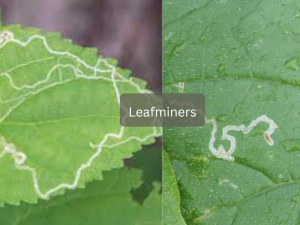
Features and symptoms:
Small flies; larvae are tiny, worm-like maggots. Larvae tunnel through leaves, creating distinctive white trails.
Management:
Remove and destroy affected leaves, use yellow sticky traps for adults, and apply insecticides for severe infestations.
Solution:
To combat small flies and their larvae that tunnel through leaves, apply BT Thuricide. This targeted insecticide effectively controls infestations while preserving the health of your plants.
Leafroller (Omnivorous leafroller, Platynota stultana)
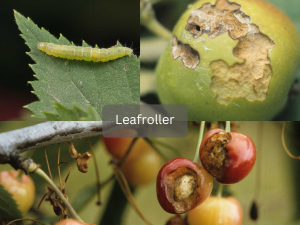
Features and symptoms:
Moth larvae that roll leaves to form protective shelters. Rolled and tied leaves, feeding damage within the rolled leaves.
Management:
Monitor and remove rolled leaves, use pheromone traps for moths, and apply insecticides if necessary.
Solution:
For leaf-rolling moth larvae, apply BT Thuricide. This insecticide effectively targets the larvae within their shelters, protecting your plants from further damage.
Thrips

Features and symptoms:
Small, slender insects with fringed wings.Stippling on leaves, disfigured flowers, and scarring of fruits.
Management:
Use blue sticky traps for monitoring, introduce predatory mites, and apply insecticidal soaps or neem oil.
Solution:
To address issues with small, slender insects causing stippling on leaves and flower disfigurement, apply biocontrol agents like Beaveria WP or Metarhizium anisopliae. These solutions effectively control the pests while being environmentally friendly.
Tomato FruitWorm (Corn Earworm, Helicoverpa zea)
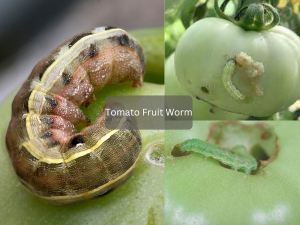
Features and symptoms:
Caterpillars vary in color, often green, brown, or pink. Bore into fruits, causing direct damage and making the fruit susceptible to rot.
Management:
Monitor for moths using pheromone traps, apply Bacillus thuringiensis or other appropriate insecticides, and remove and destroy affected fruits.
Solution:
To tackle fruit-boring caterpillars, apply Bacillus thuringiensis israelensis. This specific strain effectively targets the larvae, preventing fruit damage and subsequent rot.
Pepper Plant Diseases
Xanthomonas campestris pv. vesicatoria, Bacterial Spot

Features and symptoms:
pepper plant diseases identification can be doneunder warm, wet conditions. The symptoms include dark, watery spots on leaves and fruits that are usually surrounded by a yellow halo. Severe infections cause leaf fall and low yields.
Management:
Management of bacterial spot requires the use of disease-resistant pepper varieties and application of copper fungicides, particularly after rainfall or overhead irrigation. Rotating crops and avoidance of working in wet fields will help to prevent the spread of this disease.
Solution:
To manage pepper plant diseases and pests, apply biocontrol agents like Bactonus, or Bacillus Polymyxa. These beneficial bacteria offer a natural solution to combat the disease and promote healthy plant growth.
Powdery Mildew (Leveillula taurica)

Features and symptoms:
Powdery mildew is a fungal infection that produces white powder on the leaf’s surface. It impacts the plant’s photosynthetic capacity and vitality. The symptoms are white, powdery patches on the upper surface of leaves that can spread to cover the entire leaf. Leaves infected with the virus may turn yellow and abscise early.
Management:
Manage powdery mildew by increasing air circulation around plants and lowering humidity. Sulfur-containing fungicides can be useful. Destruction of infected plant parts helps in curtailing the spread of disease.
Solution
:To combat powdery mildew on plants, apply natural fungicides like Trianum V or Metilo. These treatments help in controlling the fungus while supporting the overall health of your plants.
Anthracnose (Colletotrichum spp.)

Features and symptoms:
Anthracnose, caused by a fungus, primarily affects the fruits of pepper plants, especially during warm, humid conditions. It manifests as sunken, water-soaked lesions on fruits, which can enlarge and darken over time.
Management:
Management strategies include avoiding overhead watering to reduce humidity, removing and destroying infected fruits, and applying organic fungicides like copper-based products or Bacillus subtilis strains. Ensuring good air circulation and practicing crop rotation are also effective.
Solution:
For controlling Anthracnose in pepper plants, consider applying Trianum Shield or Trichoderma Aspellum. These organic fungicides target the fungus effectively, aiding in maintaining healthy fruit production.
Cercospora capsici

Features and symptoms:
Small, circular, water-soaked spots on leaves, stems, petioles, or peduncles, maturing to white or brown centers with a brown to red or purple border.
Management:
Remove and destroy crop debris, apply appropriate fungicides, and practice crop rotation to reduce incidence.
Solution:
To manage Cercospora Leaf Spot in plants, apply natural fungicides like Trianum V, Bacillus Velezensis, or Bacillus Amyloliquefacens. These treatments help control the disease while supporting plant health.
Damping-off (Pythium spp., Rhizoctonia solani)

Features and symptoms:
Seedlings collapsing and dying, dark, shriveled stems near the soil line, water-soaked discolored roots.
Management:
Avoid planting in poorly draining, cool, wet soil, use high-quality seed, and treat seeds with fungicide.
Solution:
For seedlings affected by collapsing and root issues, apply Trianum Shield, or Trichoderma Aspellum. These biofungicides effectively prevent and treat fungal problems, promoting healthy seedling growth.
Fusarium Wilt (Fusarium oxysporum)

Features and symptoms:
Yellowing of foliage, wilting of upper leaves, red-brown discoloration of vascular tissue.
Management:
Plant in well-draining soils, avoid waterlogging, and use resistant varieties.
Solution:
To address plant issues like yellowing foliage and wilting leaves, apply Trianum shield or Trichoderma Aspellum. These treatments help protect plants by enhancing their resistance to soil-borne diseases.
Gray Leaf Spot (Stemphylium spp.)

Features and symptoms:
Small, red-brown spots on leaves, expanding to larger lesions with white or gray centers.
Management:
Ventilate nursery beds well, remove crop debris, and apply fumigant fungicides if necessary.
Solution:
To combat the issue, apply Trianum V, Bacillus Velezensis, or Bacillus Amyloliquefacens. These biofungicides effectively manage the problem while promoting plant health.
Southern Blight (Sclerotium rolfsii)

Features and symptoms:
Sudden wilting of leaves, yellowing foliage, browning stem and branches, stem covered with fan-like mycelial mat.
Management:
Remove infected plants, avoid overcrowding, rotate crops, plow debris deep into soil, and use stem barriers.
Solution:
Apply Trianum V to the targetted problem, aiding in restoring plant health and vigor.
Verticillium Wilt (Verticillium spp.)

Features and symptoms:
Stunted growth, yellowing of lower leaves, wilting, and plant death.
Management:
Rotate crops every 3–4 years, use soil fumigation and/or solarization.
Solution:
Apply Cropium to enhance soil health, supporting plant vitality and preventing diseases.
Bacterial Canker (Clavibacter michiganensis)

Features and symptoms:
Small, raised, white lesions on leaves and fruit, turning brown and necrotic.
Management:
Use certified seed and disease-free transplants, treat seeds with hot water, sanitize equipment, rotate crops.
Solution:
Apply biocontrol agents Bactonus, or Bacillus Polymyxa to effectively combat bacterial infections and support overall plant health.
Bacterial Spot (Xanthomonas campestris)
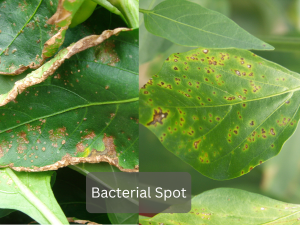
Features and symptoms:
Water-soaked lesions on leaves, brown cankers on stems, cracked brown lesions on fruit.
Management:
Use disease-free planting material, remove and destroy crop debris, plow material under soil.
Solution:
Apply the biocontrol agents like Bactonus, orBacillus velezensis, effectively target the problem, promoting healthier plant growth.
Bacterial Wilt (Ralstonia solanacearum)

Features and symptoms:
Wilting of upper leaves, especially on hot days, brown vascular tissue in stems.
Management:
Use disease-free seedlings, avoid excessive irrigation, rotate with non-susceptible crops.
Solution:
Applying Bactonus, Bacillus velezensis, or Bacillus Polymyxa can effectively help manage these symptoms, supporting healthier plant development.
Nitrogen Deficiency (no graphic)
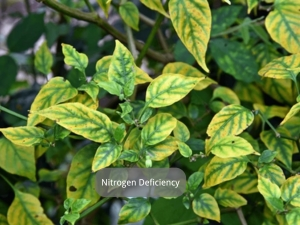
Features and symptoms:
Reduced growth, general yellowing of leaves, reduced and pale fruit size.
Management:
Apply appropriate amounts of nitrogen fertilizer.
Solution:
Apply Metilo, Bacillus megaterium, or Bacillus Polymyxa to treat nutrient deficiencies, promoting healthier plant growth and getting rid of pepper plant diseases and pests.
Mosaic Virus (Cucumber mosaic virus)

Features and symptoms:
Mosaic patterns on leaves, leaves distorted and curled, slow plant growth.
Management:
Remove weeds, use reflective mulches to deter aphids.
Solution:
Apply Bacillus Subtilis, Bacillus velezensis, or Bacillus Amyloliquefacens to mitigate symptoms and support healthy plant growth.
Tomato Spotted Wilt Virus (TSWV)

Features and symptoms:
Spotted and bronzed leaves, plant wilting, fruit with concentric rings.
Management:
Control thrips vector, remove infected plants.
Solution:
For issues such as spotted and bronzed leaves, wilting plants, and fruit with concentric rings, apply a combination of Bacillusand Trichoderma. These natural agents effectively control the symptoms and improve overall plant health.
Phytophthora Blight (Phytophthora capsici)

Features and symptoms:
Black lesions on stems, wilting plant, circular gray-brown lesions on leaves, dark lesions on fruit.
Management:
Plant disease-free transplants, manage water carefully, rotate crops, apply appropriate fungicide.
Solution:
To combat black lesions on stems, wilting plants, and circular gray-brown lesions on leaves and fruit, apply Trianum V. These biofungicides target the disease effectively, promoting healthier plant growth.
Integrated Pest Management (IPM)
Integrated Pest Management (IPM) is a comprehensive approach that utilizes multiple strategies to control pests and diseases. It highlights ongoing monitoring for early detection, biological control, cultural practices and the judicious use of organic pesticides. Adopting IPM, growers can protect ecological balance while ensuring sustainable pepper production.
Conclusion
The pepper plant diseases and peststhat affect peppers must be well understood for successful pepper cultivation. The use of sustainable management practices ensures the production of healthy crops and abundant harvests. This guide can be used as a tool to fight these challenges, encouraging the adoption of sustainable and eco-friendly practices in pepper cultivation.

Related Products
CONTACT US

Office 38/1502, No 660,Hanguang Rt., Changsha City, Hunan, China
































